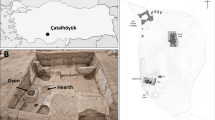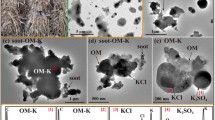Abstract
The burning of biomass in pizza ovens can be an important source of air pollution. Fine particulate matter represents one of the most aggressive pollutants to human health, besides the potential to interfere with global radiative balance. A study in real-world condition was performed in three pizzerias in São Paulo city. Two of the pizzerias used eucalyptus timber logs and one used wooden briquettes. The results from the three pizzerias revealed high average concentrations of PM2.5: 6171.2 μg/m3 at the exit of the chimney and 68.2 μg/m3 in indoor areas. The burning of briquette revealed lower concentrations of PM2.5. BC represented approximately 20% and 30% of the PM2.5 mass concentration in indoor and at chimney exhaust, respectively. Among the trace elements, potassium, chlorine and sulphur were the most prevalent in terms of concentration. Scanning electron microscopy (SEM) analysis revealed particles with an individual and spherical morphology, i.e. the conglomeration of spherical particles, flattened particles in the formation of fibres, the overlapping of layers and the clustering of particles with sponge-like qualities. The average emission factors for PM2.5 and BC due to the burning of logs were 0.38 g/kg and 0.23 g/kg, respectively. The total emissions of PM2.5 and BC were 116.73 t/year and 70.65 t/year, respectively, in the burning of timber logs.






Similar content being viewed by others
References
Alves C, Gonçalves C, Fernandes AP, Tarelho L, Pio C (2011) Fireplace and woodstove fine particle emissions from combustion of western Mediterranean wood types. Atmos Res 101:692–700
Arana A, Loureiro AL, Barbosa HM, Van Grieken R, Artaxo P (2014) Optimized energy dispersive X-ray fluorescence analysis of atmospheric aerosols collected at pristine and perturbed Amazon Basin sites. X-Ray Spectrom 43(4):228–237
Artaxo P, Rizzo LV, Paixao MA, Lucca S, Oliveira PH, Lara LL,Wiedemann KT, Andreae MO, Holben B, Shaffer J, Correia AL, Pauliquevis TM (2009) Aerosol particles in Amazonia: their composition, role in the radiation balance, cloud formation and nutrient cycles. LBA Synthesis Book Springer. Geophys Monogr 186:235–254
BEN (2016) Balanço Energético Nacional (2016) (in Portuguese-available online at (http://www.epe.gov.br/pt/publicacoes-dadosabertos/publicAtmospheric Pollutionacoes/Balanco-Energetico-Nacional-2016)
Bhattacharya SC, Abdul Salam P, Sharma M (2000) Emissions from biomass energy use in some selected Asian countries. Energy 25:169–188
Bond TC, Zarzycki C, Flanner MG, Koch DM (2011) Quantifying immediate radiative forcing by black carbon and organic matter with the specific forcing pulse. Atmos Chem Phys 11:1505–1525
Branis ME, Kolmazníková J (2010) Monitoring of long-term personal exposure to fine particulate matter (PM2,5). Air Qual Atmos Health 3:235–243
Brauer M, Ebelt ST, Fisher TV, Brum J, Petkau AJ, Vedal S (2001) Exposure of chronic obstructive pulmonary disease patients to particles: Respiratory and cardiovascular health effects. J Expo Sci Env Epid 11:490–500
Buonanno G, Morawska L, Stabile L, Viola A (2010) Exposure to particlenumber, surface area and PM concentrations in pizzerias. Atmos Environ 44:3963–3969
Calvo AL, Alves CA, Duarte M, Nunes T, Tarelho LAC (2014) Characterization of operating conditions of two residential wood combustion appliances. Fuel Process Technol 126:222–232
CETESB (2018) Relatório de qualidade do ar no Estado de São Paulo (2016) (in Portuguese - available online at www.cetesb.sp.gov.br
Dasch JM (1982) Particulate and gaseous emissions from wood burning fireplaces. Environ Sci Technol 16(10):639
Fine M, Cass R, Simoneit T (2004) Chemical characterization of fine particle emissions from the wood stove combustion of prevalent United States tree species. Environ Eng Sci 21:705–721
Gentil LVB (2008) Tecnologia e economia do briquete de madeira. Doctoral Thesis in Forestry Science – University of Brasília
Gianelle V, Colombi C, Caserini S, Ozgen S, Galante S, Marongiu A, Lanzani G (2013) Benzo(a)pyrene air concentrations and emission inventory in Lombardy region, Italy. Atmos Pollut Res 4:257–266
Gonçalves C, Alexandre C, Casimiro P, Célia A, Christoph S, Fátima M, Fernando C, Margarita E (2010) Characterisation of PM10 emissions from woodstove combustion of common woods grown in Portugal. Atmos Environ 44:4474–4480
Hussein T, Glytsos T, Ondracek J, Dohanyosova P, Zdímal V, Hameri K, Smolik J, Lararidis M, Smolik J, Kulmala M (2006) Particle size characterization and emission rates during indoor activities in a house. Atmos Environ 40(23):4285–4387
IPCC (2013) Climate change 2013: the physical science basis. In: Stocker TF, Qin D, Plattner G-K, Tignor M, Allen SK, Boschung J, Nauels A, Xia Y, Bex V, Midgley PM (eds) Contribution of working group I to the fifth assessment report of the intergovernmental panel on climate change. Cambridge University Press, Cambridge, United Kingdom and New York, NY, USA 1535 pp
Jacobson MZ (2002) Atmospheric pollution – history, Science and Regulation. Cambridge University Press
Johansson L, Leckner B, Gustavsson D, Cooper C, Tullin C, Potter A (2004) Emission characteristics of modern and old type residential boilers hred with woods logs and wood pellets. Atmos Environ 38:4183–4195
Kliucininkas L, Krugly E, Stasiulaitiene I, Radziuniene I, Prasauskas T, Jonusas A, Kauneliene V, Martuzevicius D (2014) I ndoor-outdoor levels of size segregated particulate matter and monopolycyclic aromatic hydrocarbons among urban areas using solid fuels for heating. Atmos Environ 07:83–93
Kramer U, Herder C, Sugiri D, Strassburguer, Schikowski T, Ranft U, Rathmann W (2010) Traffic-related air pollution and incidente type 2 diabetes: results from the SALIA cohort study. Environ Health Perspect 118:1273–1279
Kumar P, Andrade MF, Ynoue RY, Fornaro A, Freitas ED (2016) New directions: from biofuels to wood stoves: the modern and ancient air quality challenges in the megacity of São Paulo. Atmos Environ 140:364–369
Majumdar D, Chintada J, Sahu J, Chapati Rao CV (2013) Emissions of greenhouse and non-greenhouse air pollutants from fuel combustion in restaurant industry. Environ Sci Technol 10:995–1006
Martins MAG (2010) Variação da composição e toxicidade do material particulado ao longo do dia na cidade de São Paulo. São Paulo. Doctoral thesis. Medical Faculty of São Paulo, University of São Paulo
Nordin E, Bergvall C, Boman C, Eriksson A, Genberg J, Hirvonen M, Westerholm R, Jalavi P, Jokiniemi J, Nystron R, Pagels J, Roldin P, Uski O (2014) Influence of ozone initiated processing on the toxicity of aerosol particles from small scale wood combustion. Atmos Environ 102:282–289
Ozgen M, Alessandro M, Carmen M, Elisabetta A, Francesca H, Gabriele M, Michele G, Silvia G, Stefano C (2014) Emission factors from small scale appliances burning wood and pellets. Environ Sci Technol 94:144–153
Peled R (2011) Air pollution exposure: who is at high risk? Atmos Environ 89:337–345
Polichetti G, Cocco S, Nunziata A, Spinali A, Trimarco V (2009) Effects of particulate matter (PM10, PM2.5 and PM1) on the cardiovascular system. Toxicology 261:1–8
Pooley FD, Mille M (1999) Air pollution and health: Composition of air pollution particles. Academic Press. 619–634.https://doi.org/10.1016/B978-0-12-352335-8.X5074-1
Rosasco FV (2009) Estudo Sazonal e caracterização do aerosol Black Carbon medido no INPE de São José dos Campos. Masters dissertation. National Institute of Special Research
Roy MM, Corscadden KW (2012) An experimental study of combustion and emissions of biomass briquettes in a domestic wood stove. Applied Energy 99(C):206–212
Sachdeva K, Attri AK (2008) Morfhological characterization of carbonaceous aggregates in soot and free fall aerosol samples. Atmos Environ 42:1025–1034
Salam A, Begum AB, Begum M, Biswas KS, Hasam M (2013) Chemical characterization of biomass burning deposits from cooking stoves in Bangladesh. Biomass Bioenergy 52:122–130
ISS (2013). Instituto Saúde e Sustentabilidade: Avaliação do impacto da poluição atmosférica no estado de São Paulo sob a visão da saúde (in Portuguese-available online at https://www.saudeesustentabilidade.org.br/instituto-publicacoes/)
Santos JM, Reis NC (2011) Caracterização e quantificação de partículas sedimentadas na Região da Grande Vitória. Fundação Espírito-Santense deTecnologia. Technical report. (in Portuguese-available online at https://iema.es.gov.br/Media/iema/CQAI/Documentos/Relatorio_Final_Particulas_Sedimentaveis_RGV_revisado.pdf)
Seinfeid JH, Pandis SN (1998) Atmospheric chemistry and physics: from air pollution to climate change. John Wiley and Sons, New York
Sexton K, Hayward SB, Liu KS, Spengler JD (1985) Characterization and source apportionment of wintertime aerosol in a wood burning community. Atmos Environ 8:1225–1236
Sgarbi FA, Salinas DTP, Santos EM, Simões AF (2013) Fuelwood as an energy source for the commercial cooking sector- an overview analysis focused in the city of São Paulo, Brazil. Biomass Bioenergy 58:313–321
Shen G, Shen H, Duan Y, Li W, Lv Y, Huang Y, Liao Y, Pei L, Shen H, Tao S, Wang B, Wang H, Wang R, Wang X, Wei S, Yuan C, Zhang Y, Zheng X, Zhu D (2012) Field measurement of emission factors of PM, EC, OC, parent, nitro and oxy-polycyclic aromatic hydrocarbons for residential briquette, coal, cake, and wood in rural Shanxi, China. Environ Sci Technol 47:2998–3005
Shen G, Shen H, Chen Y, Ding A, Huang Y, Li W, Shen H, Wu H, Tao S, Yag C, Xue M, Zhang Y, Zhu Y (2014) Comparison of carbonaceous particulate matter emission factors among different solid fuels burned in residential stoves. Atmos Environ 89:337–345
Smith SJ, Bond TC (2013) Two hundred fifty years of aerosols and climate: the end of the age of aerosols. Atmos Chem Phys 13:6419–6453
Sola C, Atis D, Sayin B, Yayala M (2011) The effects of different types of fly ash on the compressive strength properties of briquettes. Adv Mater Sci Eng:1–6
Taner S, Pekey B, Pekey H (2013) Fine particulate matter in the indoor air of barbeque restaurants: elemental compositions, sources and health risks. Sci Total Environ 455:79–87
Uski O, Jalava PL, Happo MS, Torvela T, Leskinen J, Maki-Paakkanen J, Tissari J, Sippula O, Lamberg H, Jokiniemi J, Hirvonen MR (2015) Effect of fuel zinc content on toxicological responses of particulate matter from pellet combustion in vitro. Sci Total Environ 511:331–340
Viana M, Alastueya A, Celades I, Minguillon MC, Monfortb E, Pandolfi M, Querola X (2008) Inter-comparison of receptor models for PM source apportionment: case study in an industrial area. Atmos Environ 42:3820–3832
Vieira-Filho MS, Pedrotti JJ, Fornaro A (2013) Contribution of long and midrange transport on the sodium and potassium concentrations in rainwater samples, São Paulo megacity. Atmos Environ 79:299–307
WER-World Energy Resources (2016). Published by the World Energy Council 2016. (available online at https://www.worldenergy.org/publications/entry/world-energy-resources-2016))
Weuve J, Grodstein F, Laden F, Robin C, Schwartz J, Yanosky (2012) Exposure to particulate air pollution and cognitive decline in older women. Arch Intern Med 12:219–227
Acknowledgements
The authors gratefully acknowledge the staff of the IAG (LAPAt)/USP laboratory.
Funding
This research was supported by the Coordenação de Aperfeiçoamento de Pessoal de Nível Superior (CAPES, Brazilian Research Foundation).
Author information
Authors and Affiliations
Corresponding author
Additional information
Responsible editor: Philippe Garrigues
Publisher’s note
Springer Nature remains neutral with regard to jurisdictional claims in published maps and institutional affiliations.
Rights and permissions
About this article
Cite this article
Lima, F.D.M., Pérez-Martínez, P.J., de Fatima Andrade, M. et al. Characterization of particles emitted by pizzerias burning wood and briquettes: a case study at Sao Paulo, Brazil. Environ Sci Pollut Res 27, 35875–35888 (2020). https://doi.org/10.1007/s11356-019-07508-6
Received:
Accepted:
Published:
Issue Date:
DOI: https://doi.org/10.1007/s11356-019-07508-6




